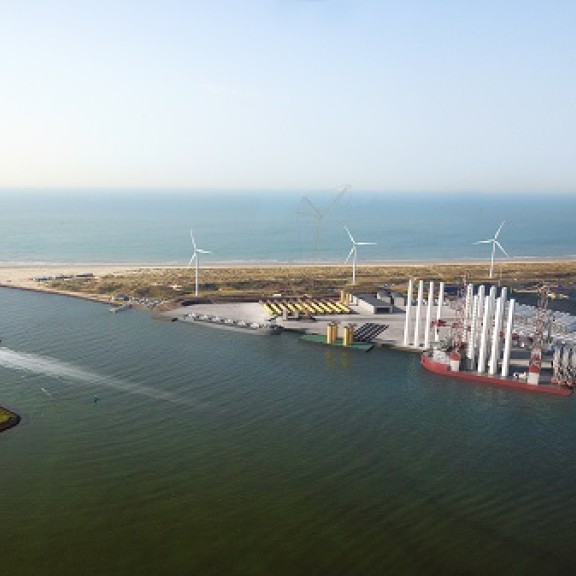
Carbon emissions in North Sea Canal Area to be reduced by half by 2030
Industrial companies based in the North Sea Canal Area seek to cut carbon emissions by 50% by 2030, bringing them down from the current level of 15 megatons. Virtually all circular waste flows must be recycled by 2050 and carbon emissions minimised.
In committing to these targets, the area aims to be among the leading regions in Europe when it comes to reducing climate change.
These are the outcomes of the Regionale Industrieklimaattafel (Regional Climate Convention for Industry) in the North Sea Canal Area, the fastest-growing region in the Netherlands and home to a large variety of industrial activities.
The outcomes were presented last week by Regional Climate Convention Chairman Tjerk Wagenaar to Manon Jansen, who chairs the Landelijke Industrieklimaattafel (National Climate Convention for Industry). Ed Nijpels, the Chairman of the Klimaatberaad (Climate Consultation), will be presenting the results today of all National Climate Conventions to Eric Wiebes, Minister of Economic Affairs and Climate Policy.
Tjerk Wagenaar of the Regional Climate Convention for Industry: ‘The North Sea Canal Area is on the brink of a major industrial energy revolution. Industrial businesses, grid operators based in and near the airport and seaport, provincial and local authorities and environmental organisations have succeeded in creating an ambitious plan and developing the numerous projects and innovations needed to advance their objective. This will allow the North Sea Canal Area to contribute significantly to achieving the climate targets set by the Dutch government and under the Paris Agreement. We have reason to be proud of all these regional players for achieving results so quickly.’
Contributions to the Dutch Climate Agreement
Key specific examples of ideas submitted to contribute to the Climate Agreement include:
- Electrification of virtually all industries, as an alternative to gas;
- Carbon capture at Tata Steel, AEB Amsterdam and HVC Groep in order to supply this carbon to growers and use it, combined with hydrogen, as a basic ingredient in the chemical industry. Carbon storage will be required in order to facilitate the latter over the long term (this would involve partial and temporary storage subject to strict terms);
- Large-scale production of renewable hydrogen in order to produce synthetic fuels using carbon;
- Use of waste heat and the generation of heat using geothermal resources, soil energy and biomass.
Calculations indicate that industrial demand for electricity is set to quadruple over the next decade, including by data centres and the electrification industry.
To prepare for this growing demand, grid operators intend to strengthen the electricity infrastructure and build a hydrogen and carbon grid, along with a heat grid to heat homes and greenhouses. This infrastructure must be in place in time, so as to allow the industrial sector to implement its plans.
Port of Amsterdam will play a facilitating role in this process. The provincial and local authorities will assess what is required in order to grant the appropriate permits without delay and make decisions regarding the limited space available – which they will then integrate into environmental plans. It will be a challenge – including for public consultations – to complete this process in a timely manner.
How these plans are to be implemented exactly depends on the future carbon price. Wagenaar: ‘If the carbon price is too low, many of these projects will not be profitable, and government support will be required. PBL Netherlands Environmental Agency (Planbureau voor de Leefomgeving) calculated earlier this year that it would cost more than €3 billion a year to reduce carbon in the Netherlands by 49%. The cost for the industrial companies in the North Sea Canal Area, by comparison, is estimated at around €500 million a year. This presents a smart and cost-effective solution for reducing climate change while still being able to maintain our current standard of living.’
Programme-based approach
The industrial partners have set seven strategic objectives to work together on developing the new industry and ensure the availability of an adequate infrastructure and the timely issue of permits. Industrial companies, public bodies, and governments are working together closely and efficiently to meet the sustainability needs of the public, businesses and governments.
- Eliminating the use of natural gas in the Amsterdam Metropolitan Area: producing renewable heat and green gas as alternatives to natural gas;
- Zero-emission transport: facilitating electricity and a charging infrastructure, hydrogen and biofuels or synthetic fuels, plus storage, transport and distribution systems;
- Waste is a resource: recycling of waste materials such as building materials, plastics, and biomass using biorefinery plants;
- Sustainable energy generation: investing in offshore wind farms and renewable hydrogen and, where possible, high-temperature geothermal energy, including the development and maintenance required;
- Renewable fuels: production, storage and transhipment of, and trade in, biofuels and synthetic fuels;
- Circular industry: closing commodity loops and supplying sustainable products and high-quality technology to the global market, including steel;
- Data centres: further developing, using circular economy principles, the Netherlands’ position as the leading European hub for data centres; this sector is expected to grow by 20% annually.
Even industrial companies not currently involved in these initiatives are invited to present their energy plans. A second tranche of projects is to follow in September, which may be incorporated into the agreement.
Follow-up
The effort involved in making all these plans a reality should not be underestimated. Wagenaar: ‘The many billions of euro to be invested will generate a profit, and we will make this happen with 70,000 people employed in the port area. We are also seeing many opportunities for sustainable growth and attractive employment.’
The partners in the Climate Convention will be further developing their plans over the next few months and decide, together with the government, which initiatives will receive government funding. After final approval in the autumn, the partners will sign the climate agreement and start implementing their plans, so that the North Sea Canal Area can take its place at the vanguard of European sustainability initiatives.